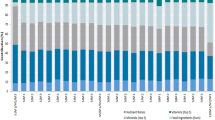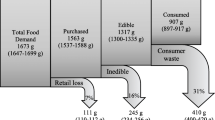Abstract
The current diet structure of Chinese residents poses significant challenges to both health and the environment. Accordingly, in this study, a diet structure optimization model was developed to simulate the diet structure of urban and rural residents in four regions of China, taking into account nutritional needs and environmental sustainability for optimization. The results showed that by optimization based on nutrition alone, nutrient adequacy ratios could increase by 2.8% on average, narrowing regional disparities. Incorporating environmental sustainability slightly reduced nutritional improvements but significantly lowered carbon emissions, water usage, and ecological footprints by 2.9%, 6.9%, and 2.4%, respectively. By simulating the optimization of diet structure, the Qinghai-Tibet region showed potential for nutrient enhancement, whereas the southern and northern regions had opportunities for environmental impact mitigation. This study highlights the significance of transitioning towards a sustainable diet structure that enhances nutritional levels while prioritizing individual and environmental well-being and emphasizes the urgent need for change. It also offers targeted recommendations for diet structures in different regions of China, thereby providing invaluable references for policymakers and other countries striving to establish sustainable and balanced diets.



Similar content being viewed by others
References
Afshin, A., Sur, P. J., Fay, K. A., Cornaby, L., Ferrara, G., Salama, J. S., et al. (2019). Health effects of dietary risks in 195 countries, 1990–2017: A systematic analysis for the Global Burden of Disease Study 2017. The Lancet, 393, 1958–1972.
Chaudhary, A., Gustafson, D., & Mathys, A. (2018). Multi-indicator sustainability assessment of global food systems. Nature Communications, 9, 848.
Chinese Nutrition Society. (2022). Dietary guidelines for Chinese residents (2022). People’s medical publishing House.
Coucke, N., Vermeir, I., Slabbinck, H., Geuens, M., & Choueiki, Z. (2022). How to reduce agri-environmental impacts on ecosystem services: The role of nudging techniques to increase purchase of plant-based meat substitutes. Ecosystem Services, 56, 101444.
Crippa, M., Solazzo, E., Guizzardi, D., Monforti-Ferrario, F., Tubiello, F. N., & Leip, A. (2021). Food systems are responsible for a third of global anthropogenic GHG emissions. Nature Food, 2, 198–209.
Donati, M., Menozzi, D., Zighetti, C., Rosi, A., Zinetti, A., & Scazzina, F. (2016). Towards a sustainable diet combining economic, environmental and nutritional objectives. Appetite, 106, 48–57.
Du, S., Wang, H., Zhang, B., & Popkin, B. M. (2020). Dietary potassium intake remains low and sodium intake remains high, and most sodium is derived from home food preparation for Chinese adults, 1991–2015 trends. The Journal of Nutrition, 150, 1230–1239.
Fang, K., He, Y., Fang, Y., & Lian, Y. (2020). Dietary sodium intake and food sources among Chinese adults: Data from the CNNHS 2010–2012. Nutrients, 12, 453.
Gephart, J. A., Davis, K. F., Emery, K. A., Leach, A. M., Galloway, J. N., & Pace, M. L. (2016). The environmental cost of subsistence: Optimizing diets to minimize footprints. Science of the Total Environment, 553, 120–127.
Geyik, Ö., Hadjikakou, M., & Bryan, B. A. (2023). Climate-friendly and nutrition-sensitive interventions can close the global dietary nutrient gap while reducing GHG emissions. Nature Food, 4, 61–73.
Hannum, E., Liu, J., & Frongillo, E. A. (2014). Poverty, food insecurity and nutritional deprivation in rural China: Implications for children’s literacy achievement. International Journal of Educational Development, 34, 90–97.
Huang, L., Wang, Z., Wang, H., Zhao, L., Jiang, H., Zhang, B., et al. (2021). Nutrition transition and related health challenges over decades in China. European Journal of Clinical Nutrition, 75, 247–252.
Liu, A., Han, A., & Chai, L. (2021). Assessing the nutrient adequacy in China’s food supply from 1965 to 2018. Nutrients, 13, 2734.
Liu, X., Xin, L., & Li, X. (2024). The global nutrition can be greatly improved with diet optimization. Resources Conservation and Recycling, 202, 107343.
Ministry of Agriculture and Rural Affairs of the People’s Republic of China. (2022). National wholesale market price information system for agricultural products.
National Bureau of Statistics of China. (2022). China statistical yearbook 2022. Beijing: China Statistics Press.
National Health Commission of the People’s Republic of China. (2017a). Chinese dietary reference intakes—Part 1: Macronutrient. Beijing: National Health Commission of the People’s Republic of China.
National Health Commission of the People’s Republic of China. (2017b). Chinese dietary reference intakes—Part 3: Trace element. Beijing: National Health Commission of the People’s Republic of China.
National Health Commission of the People’s Republic of China. (2018a). Chinese dietary reference intakes—Part 2: Macroelement. Beijing: National Health Commission of the People’s Republic of China.
National Health Commission of the People’s Republic of China. (2018b). Chinese dietary reference intakes—Part 4: Lipid-soluble vitamin. Beijing: National Health Commission of the People’s Republic of China.
National Health Commission of the People’s Republic of China. (2018c). Chinese dietary reference intakes—Part 5: Water-soluble vitamin. Beijing: National Health Commission of the People’s Republic of China.
National Health Commission of the People’s Republic of China. (2020). Report on the nutrition and chronic disease status of chinese residents. Beijing: People’s medical publishing House.
Notarnicola, B., Tassielli, G., Renzulli, P. A., Castellani, V., & Sala, S. (2017). Environmental impacts of food consumption in Europe. Journal of Cleaner Production, 140, 753–765.
Payne, C., Scarborough, P., & Cobiac, L. (2016). Do low-carbon-emission diets lead to higher nutritional quality and positive health outcomes? A systematic review of the literature. Public Health Nutrition, 19(14), 2654–2661.
Perignon, M., Masset, G., Ferrari, G., Barré, T., Vieux, F., Maillot, M., et al. (2016). How low can dietary greenhouse gas emissions be reduced without impairing nutritional adequacy, affordability and acceptability of the diet? A modelling study to guide sustainable food choices. Public Health Nutrition, 19, 2662–2674.
Song, G., Li, M., Semakula, H. M., & Zhang, S. (2015). Food consumption and waste and the embedded carbon, water and ecological footprints of households in China. Science of the Total Environment, 529, 191–197.
Springmann, M., Clark, M., Mason-D’Croz, D., Wiebe, K., Bodirsky, B. L., Lassaletta, L., et al. (2018). Options for keeping the food system within environmental limits. Nature, 562, 519–525.
Stigler, G. J. (1945). The cost of subsistence. Journal of Farm Economics, 27(2), 303–314.
Tilman, D., & Clark, M. (2014). Global diets link environmental sustainability and human health. Nature, 515, 518–522.
Vermeulen, S. J., Campbell, B. M., & Ingram, J. S. (2012). Climate change and food systems. Annual Review of Environment and Resources, 37, 195–222.
Wang, L., Gao, B., Hu, Y., Huang, W., & Cui, S. (2020). Environmental effects of sustainability-oriented diet transition in China. Resources, Conservation and Recycling, 158, 104802.
World Health Organization. (2020). The state of food security and nutrition in the world 2020: transforming food systems for affordable healthy diets (Vol. 2020). Food and Agriculture Organization.
Xin, L. (2021). Dietary structure upgrade of China’s residents, international trade and food security. Journal of Natural Resources, 36, 1469–1480.
Xiong, X., Zhang, L., Hao, Y., Zhang, P., Chang, Y., & Liu, G. (2020). Urban dietary changes and linked carbon footprint in China: A case study of Beijing. Journal of Environmental Management, 255, 109877.
Xu, Y., Zhu, S., Zhang, T., Wang, D., Hu, J., Gao, J., et al. (2020). Explaining income-related inequalities in dietary knowledge: Evidence from the China health and nutrition survey. International Journal of Environmental Research and Public Health, 17, 532.
Yang, Y. (2018). China Food Composition Tables. Peking University Medical Press.
Yin, J., Zhang, X., Huang, W., Liu, L., Zhang, Y., Yang, D., et al. (2021). The potential benefits of dietary shift in China: Synergies among acceptability, health, and environmental sustainability. Science of the Total Environment, 779, 146497.
Yu, D., He, Y., Guo, Q., Fang, H., Xu, X., Fang, Y., et al. (2016). Trends of energy and nutrients intake among Chinese population in 2002–2012. Wei Sheng yan jiu Journal of Hygiene Research, 45, 527–533.
Yue, A., Marsh, L., Zhou, H., Medina, A., Luo, R., Shi, Y., et al. (2016). Nutritional deficiencies, the absence of information and caregiver shortcomings: A qualitative analysis of infant feeding practices in rural China. PLoS ONE, 11, e0153385.
Zhang, J., Wang, Z., Du, W., Huang, F., Jiang, H., Bai, J., et al. (2021). Twenty-five-year trends in dietary patterns among Chinese adults from 1991 to 2015. Nutrients, 13, 1327.
Zhang, L., Wang, Z., Wang, X., Chen, Z., Shao, L., Tian, Y., et al. (2020). Prevalence of overweight and obesity in China: Results from a cross-sectional study of 441 thousand adults, 2012–2015. Obesity Research and Clinical Practice, 14, 119–126.
Zhao, L., Kase, B., Zheng, J., & Steck, S. E. (2023). Dietary patterns and risk of lung cancer: A systematic review and meta-analyses of observational studies. Current Nutrition Reports, 12(2), 1–20.
Acknowledgements
This work was supported by the National Natural Science Foundation of China [grant number 42171259] and the Key Projects of the National Natural Science Foundation of China [grant number 41930757].
Funding
National Natural Science Foundation of China, 42171259, Liangjie Xin, 41930757, Liangjie Xin.
Author information
Authors and Affiliations
Corresponding author
Ethics declarations
Conflict of Interest
The authors declared that they have no conflict of interest.
Supplementary Information
Below is the link to the electronic supplementary material.
Rights and permissions
Springer Nature or its licensor (e.g. a society or other partner) holds exclusive rights to this article under a publishing agreement with the author(s) or other rightsholder(s); author self-archiving of the accepted manuscript version of this article is solely governed by the terms of such publishing agreement and applicable law.
About this article
Cite this article
Liu, X., Xin, L. A more plant-based diet can boost public health and reduce environmental impact in China. Food Sec. 16, 411–422 (2024). https://doi.org/10.1007/s12571-024-01435-2
Received:
Accepted:
Published:
Issue Date:
DOI: https://doi.org/10.1007/s12571-024-01435-2




